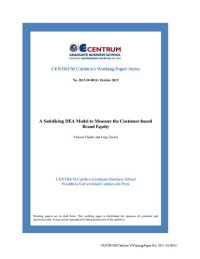
Ebook: A Satisficing DEA Model to Measure the Customer-based Brand Equity
Author: Vincent Charles and Jorge Zavala
- Genre: Business // Management
- Tags: Customer-based brand equity, Data envelopment analysis, Efficiency, Factor analysis, Satisficing
- Series: CENTRUM Católica’s Working Paper Series
- Year: 2015
- Publisher: Pontificia Universidad Católica del Perú (PUCP) - CENTRUM
- City: Lima
- Language: English
- pdf
Ever since the inception of brand values, these have become a benchmark for many data-driven
strategies, eventually providing a basis for vertical/horizontal integrations, as well. In recent
decades, brands have become comparable across the industries, based on their value derived
either from the customer perception or in terms of the firm financials. Numerous models have
been developed in time to measure the customer-based brand equity; nevertheless, they all
evaluate brand equity in an absolute sense. The present research paper provides an avenue to
measure the customer-based brand equity in a relative sense using a satisficing DEA model. The
information for this model has been collected through a customer-based survey questionnaire in
line with predefined brand equity dimensions, which have been verified through a confirmatory
factor analysis. We demonstrate the approach by means of applying the proposed model to
measure the efficiency of cell phone brands.
Keywords: Customer-based brand equity; Data envelopment analysis; Efficiency; Factor
analysis; Satisficing.
strategies, eventually providing a basis for vertical/horizontal integrations, as well. In recent
decades, brands have become comparable across the industries, based on their value derived
either from the customer perception or in terms of the firm financials. Numerous models have
been developed in time to measure the customer-based brand equity; nevertheless, they all
evaluate brand equity in an absolute sense. The present research paper provides an avenue to
measure the customer-based brand equity in a relative sense using a satisficing DEA model. The
information for this model has been collected through a customer-based survey questionnaire in
line with predefined brand equity dimensions, which have been verified through a confirmatory
factor analysis. We demonstrate the approach by means of applying the proposed model to
measure the efficiency of cell phone brands.
Keywords: Customer-based brand equity; Data envelopment analysis; Efficiency; Factor
analysis; Satisficing.
Download the book A Satisficing DEA Model to Measure the Customer-based Brand Equity for free or read online
Continue reading on any device:

Last viewed books
Related books
{related-news}
Comments (0)